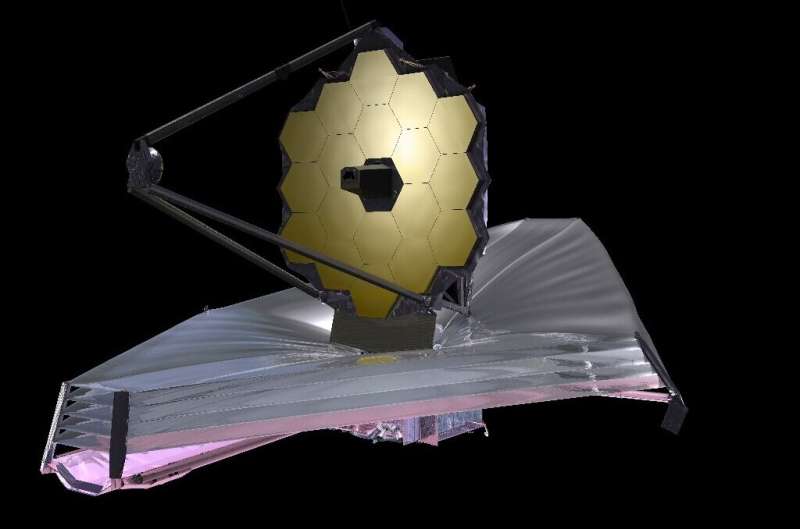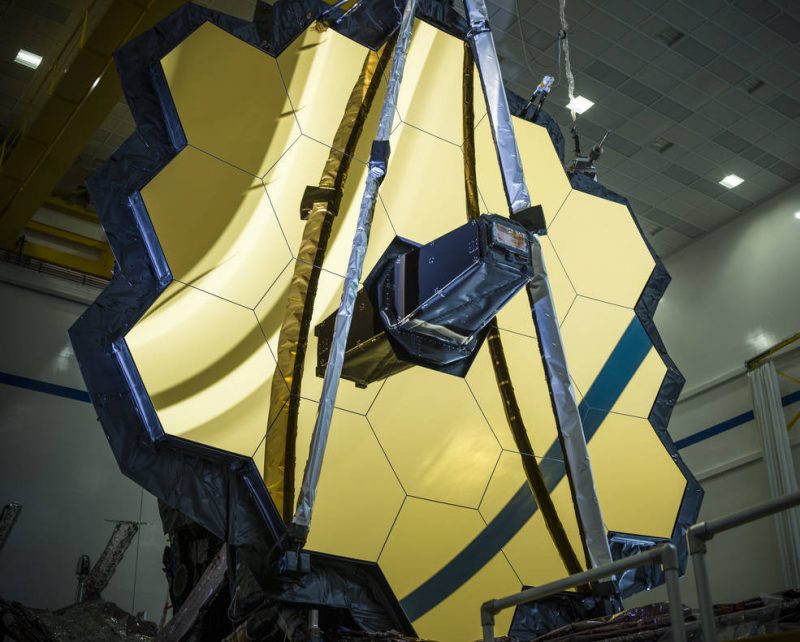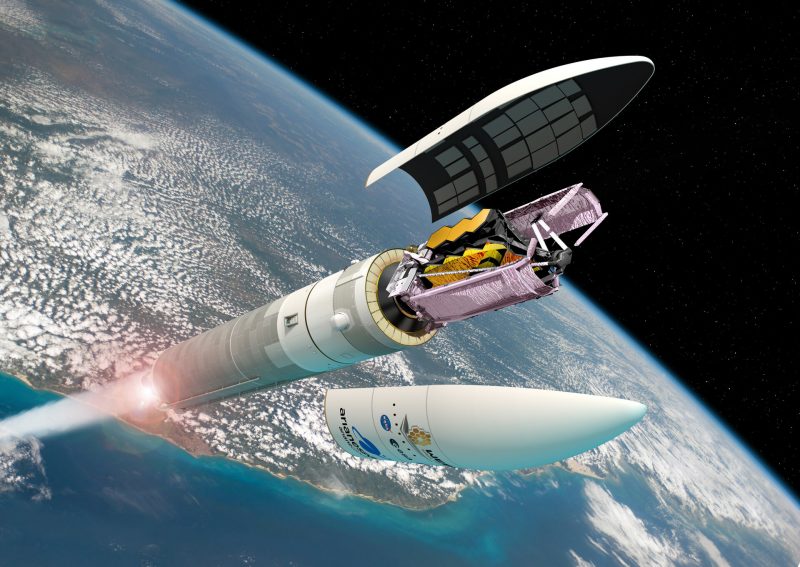First Webb images coming soon!
NASA administrator Bill Nelson said recently that – when the space agency releases the first Webb images on July 12 – one of the images will be the deepest ever captured of our universe. He told a press briefing on June 29, 2022, at the Space Telescope Science Institute in Baltimore that the image will reveal a part of space:
… Farther than humanity has ever looked before.
And he noted that Webb – successor to the Hubble Space Telescope – will be able to peer even farther than this new image. It’ll look farther outward into space, and therefore farther back in time, than any telescope before. That fact brings to mind a decades-old question in astronomy: how close can we see to the Big Bang itself, the event in which our universe was born? More about seeing back to the Big Bang below.
In the meantime, NASA – with the European Space Agency (ESA) and the Canadian Space Agency (CSA) – is planning to release the James Webb Space Telescope’s first full-color images and spectroscopic data during a televised broadcast beginning at 14:30 UTC (10:30 a.m. EDT) on July 12, from NASA’s Goddard Space Flight Center in Greenbelt, Maryland. Events will extend into the following day. Details on how to see the images, and a schedule of events, below.
Count down to the big real of Webb’s first images here.

Webb images release day is July 12
NASA has said it will release Webb’s first images one by one on July 12. Each image will simultaneously be made available on social media as well as on the agency’s website at:
Note that Webb’s first images are embargoed until July 12 and will not be available before their public release.
NASA invites you to stay connected with the mission and share your experience with Webb’s first images on Twitter, Facebook, and Instagram with #UnfoldTheUniverse. You can follow and tag these accounts:
Twitter: @NASA, @NASAWebb
Facebook: NASA, NASAWebb
Instagram: NASA, @NASAWebb
Here is a list of release activities (all times Eastern):
Tuesday, July 12, activities: Starting at 10:30 EDT
Formal Image Release – Live coverage of the image release broadcast will air on NASA TV, the NASA app, and the agency’s website. The public also can watch live on Facebook, Twitter, YouTube, Twitch, and Daily Motion.
NASA Social: NASA will host an in-person NASA Social on Tuesday, July 12. Participants will join as guests for the in-studio filming of the televised broadcast at NASA Goddard, tour NASA Goddard and STScI facilities, and interact with experts from the Webb mission.
Wednesday, July 13, activities: Starting at 3 p.m. EDT
NASA Science Live: Webb experts will answer questions about the first images and data in a NASA Science Live show. The broadcast, Webb’s First Full-Color Images Explained, will air live on the NASA Science Live website, as well as YouTube, Facebook, and Twitter. Viewers of this episode can submit questions on social media using the hashtag #UnfoldtheUniverse or by leaving a comment in the chat section of the Facebook or YouTube stream.
At the same time, NASA also will broadcast a live social media event in Spanish on its NASA en español YouTube, Facebook, and Twitter accounts. Webb experts Begoña Vila and Néstor Espinoza will discuss the release of the first images and take questions from followers.
NASA Social: The agency will host a second in-person NASA Social on Wednesday, July 13. Participants will join as guests for the in-studio filming of the televised broadcast at NASA Goddard, tour NASA Goddard and STScI facilities, and interact with experts from the Webb mission.
Activities throughout the summer
Webb Community Events: The public can also join in the excitement of Webb’s first full-color images by attending one of the many official Webb Space Telescope Community Events taking place across the country this summer. The list of events celebrating Webb’s first images is available online and updated frequently.

How close will we see to the Big Bang?
How far away will Webb be able to see? As you probably know, looking outward in space is the same as looking back in time. That’s because light – the fastest-moving stuff in the universe – doesn’t travel infinitely fast. It travels at a finite speed (186,000 miles per second, or about 300,000 kps). For decades now, astronomers have wondered … if we could look far enough away in space, how close could we get to seeing the Big Bang in which our universe was born? NASA said that, at present:
… The earliest cosmological observations date to within 330 million years of the Big Bang. But, with Webb’s capacities, astronomers believe they will easily break the record.
The Big Bang happened 13.8 billion years ago. NASA explained:
Because the universe is expanding, light from the earliest stars shifts from the ultraviolet and visible wavelengths it was emitted in, to longer infrared wavelengths, which Webb is equipped to detect at an unprecedented resolution.
So how close will we see to the Big Bang? And what will we see? No one can answer these questions yet. But – as is the case whenever a new big and powerful telescope comes online – we know we’ll see things that astound us, and that help reveal our place in the cosmos.
Read more: Webb Telescope and the Big Bang

Webb launched in late 2021
So the Webb is a marvelous machine. The dream to build it began in 1996, when an 18-member committee of astronomers formally recommended that NASA develop a space telescope that would view the heavens in infrared light. Launch was initially planned for 2007. The price tag was initially US $500 million. Then the delays began.
Webb finally launched to space on December 25, 2021, from the Guiana Space Center (sometimes called Europe’s Spaceport) at Kourou in French Guiana.
Following launch, the telescope began a month-long journey to the sun-Earth Lagrange point known as L2. This point in the sun-Earth system lets the spacecraft “hover” with respect to Earth as both Earth and the spacecraft orbit the sun. The point is about four times the moon’s distance away (about 1 million miles away from the Earth, or about 1.6 million km). On January 24, 2022, a mid-course correction burn inserted Webb into its final orbit at L2.
The Webb ground crew has spent the intervening months in a shake-down phase for the telescope, making sure its mirrors are fully aligned and its instruments are working correctly. Webb did release some test images in May 2022.
Webb will explore every phase of cosmic history – from within the solar system to the most distant observable galaxies in the early universe – and everything in between.

How long will Webb last?
NASA deputy administrator Pam Melroy said at the press briefing in Baltimore on June 29, 2022, that, thanks to an efficient launch by NASA’s partner Arianespace, the telescope could stay operational for 20 years, double the lifespan that was originally envisaged. She commented:
Not only will those 20 years allow us to go deeper into history and time, but we will go deeper into science because we have the opportunity to learn and grow and make new observations.
Bottom line: On July 12, NASA will release the much-anticipated first Webb images, including the deepest image of our universe that has ever been taken.
The post First Webb images coming July 12. Watch here. first appeared on EarthSky.
0 Commentaires